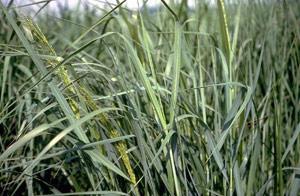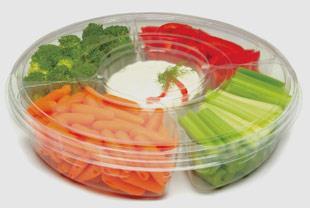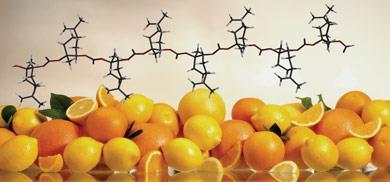Soaring oil prices could see biomass become competitive as a source for chemicals traditionally derived from petroleum. Andrew Scott investigates
Soaring oil prices could see biomass become competitive as a source for chemicals traditionally derived from petroleum. Andrew Scott investigates
Flying over the green fields of the US mid-west, molecular biologist and entrepreneur Oliver Peoples, a co-founder of Metabolix, a US biopolymer company, can reflect on the warm welcome he has received from the agricultural community in the US corn belt. Unexpectedly warm, some might think, for the chief scientific officer of a company devoted to producing plastics and fuels. But looking out across the agricultural panorama, Peoples can envisage what he believes will be some of the key chemical factories of the future - crop plants that grow plastics.
We live in an oil-based economy, but the oil will run out and oil prices are already drifting upwards. At the same time, the technology to produce plastics from crop plants is steadily improving and the price of bioplastic is becoming more competitive. Many scientists, entrepreneurs and key players in the big petrochemical companies are preparing for the day when the economics swap over permanently, and we move into a future of plastics growing in endless acres of green fields.

In 2005, Metabolix won the US presidential green chemistry challenge award for small business for its work on producing plastics using biotechnology. The unique feature of Metabolix’s work is that it synthesises complete and industrially useful polymers inside living cells, rather than just using biology to create the monomers. Both strategies are likely to prove viable, but at present Metabolix is probably the closest to achieving the futuristic vision of fields of green that actually grow plastics rather than foods and fibres. It is not there yet, because although in the process of commercialising its system in microbes (in partnership with Archer Daniels Midland, a US firm that turns crops into commercial products) it cannot yet offer a viable option for crop plants and the opportunities for large scale production that would bring. But the work to offer farmers plastic-producing plants as an attractive alternative business scenario is well advanced.
Modifying Nature’s plastics
The Metabolix strategy focuses on producing polyhydroxyalkanoates (PHAs), polyesters with a variable central chain length and variability in their side chain; these are genuine thermoplastic materials produced naturally by many species of bacteria (see fig). The first such bioplastic to be produced commercially was ’Biopol’, marketed as a biodegradable plastic by Monsanto, until the rights were acquired by Metabolix in 2001. The company now produces a wider range of more useful PHAs using bacterial fermentation, but compared with petroleum-based plastics production this approach remains expensive and small scale.
The key to making PHAs on a large scale and at a cost that could compete with the petrochemical option is to use genetic engineering to create plants that will produce them in high yields. To date, most of the chemistry and molecular biology has been explored using Arabidopsis, a small weed that is an excellent model system but not a suitable plant for commercial-scale production. Metabolix is now moving towards producing PHAs in perennial crop plants such as switchgrass (Panicum virgatum).

’It is a very plausible scenario to generate a billion tonnes per year annual harvest of switchgrass biomass,’ says Peoples. This would not adversely affect US food crop growth because of the current over-production of food.
Key obstacles need to be overcome to make this vision a reality. At present Metabolix has achieved the production of small amounts of PHAs in switchgrass, but the yield needs to be increased greatly. ’We know it will work,’ says Peoples, ’It’s just a question of timing and getting all the pieces together to make it happen.’ Metabolix is aiming to deliver a viable crop plant that generates economic yields of PHAs within four years from now. And once that happens Peoples believes that the ’compelling economic and environmental case’ for exploiting the option will ensure that it rapidly builds a significant market share.
While working on the time-consuming molecular biology to create its first commercial crop plant, Metabolix also reports good progress in the processing and manufacturing technology for PHAs. ’These materials can now be run through standard injection moulding machinery at speeds equivalent to existing materials,’ says Peoples. Extracting the plastics from harvested cells can be achieved by straightforward solvent extraction or aqueous processing steps. And varying the hydrocarbon chain length and the characteristics of the side chain offers plenty of options to create plastics with a wide range of useful properties.
The monomer option
While Metabolix pursues its dream of green fields busy assembling finished plastics before the crop is harvested, other companies are much further forward with the simpler strategy of using crop plants to grow the chemical feedstocks for monomer creation. Bioplastics created from corn starch are already capturing an increasing market share, and their significance seems set to increase.
NatureWorks, based in Minneapolis, US, has used this alternative strategy to produce what it hails as ’the world’s first greenhouse-gas neutral polymer derived from 100 percent annually renewable resources’. It harvests corn starch, enzymically hydrolyses it into glucose, and uses microbial fermentation to convert the glucose to lactic acid. The lactic acid is then polymerised into polylactic acid (PLA).

’The stability of corn prices versus crude oil has made PLA very attractive to companies looking at how they can produce innovative products with the greatest degree of reliable cost forecasting,’ says Kathleen Bader, former president and CEO of NatureWorks. She points out that the NatureWorks PLA was ’price-competitive’ with polyethylene terephthalate (PET) in 2005, leading to a 170 per cent increase in sales compared with 2004. Many thousands of stores in the US, Europe and Asia are now selling PLA products, ranging from food packaging to soft-furnishing fibres. The material’s versatility is being demonstrated by a new application in speciality gift and retail cards, where it is replacing polyvinyl chloride (PVC). As a wholly owned stand-alone company of Cargill Dow, NatureWorks has some big backing behind its expansion.
Another big player, Dupont, has its Sorona polymer that will soon be partly made using a similar strategy for creating monomers from crops. One of the two monomers for Sorona, currently made from petroleum, will increasingly be made from corn. The plans rely on fermenting corn starch into malonic acid, followed by catalytic hydrogenation to propan-1,3-diol (PDO). PDO is co-polymerised with terephthalic acid to form Sorona, which is already used in applications including clothing, textiles and packaging.

’The world is in a position today where we can no longer afford to rely solely on oil and oil-derived products to sustain us,’ said DuPont’s chairman and CEO Charles Holliday when announcing a joint venture with Tate & Lyle to build a new plant in Loudon, Tennessee, US, to produce PDO from corn starch. The plant should open in late 2006, and according to Dupont spokeswoman Michelle Reardon, will be ’the largest industrial aerobic fermentation unit in the world’. It will significantly increase the proportion of Sorona made from corn-derived PDO rather than from petroleum.
Even using 100 per cent bio-PDO, however, Sorona will only be a partial biopolymer, because only one of the two monomers will have the non-petroleum-based ’green’ credentials. This hybrid approach, however, illustrates another way in which agriculturally produced chemicals can be expected to eat increasingly into petroleum’s dominance.
Another hybrid strategy is to generate composite materials in which natural plant fibres from crops such as cotton and jute are combined with petroleum-based plastics. Such products are already used in cars manufactured by companies such as Ford, General Motors and Chrysler.
Around the world
Activity in Europe is more limited than in the US. This can partly be attributed to European public and governmental concerns about genetically engineered plants, compared with the relative enthusiasm for such new technology in the US.
Growing significant amounts of plastics in plants, as opposed to simple monomers, will require genetic manipulation to get the plants to make the plastics we want in high yields. The issue has been addressed by the European Commission’s Plants for the Future technology platform, but is largely at the stage of ideas and policy statements rather than firm action.
A major player in Asia is the biotechnology division of Toyota, which produces bioplastics for itself and began incorporating them in some new cars in 2003. Toyota expects its production of biodegradable plastics to become a $40 billion (?22 billion) per year business by 2020, when the company predicts that one fifth of the world’s plastic will be derived from biological sources. It has declared its long-term intention to become the major global provider of bioplastics. Kozaburo Tsukishima, general manager of Toyota’s biotechnology and afforestation division has been widely reported as saying that bioplastics may have the biggest growth potential of all its operations.
David Michael of Australian consultants Wondu Holdings has surveyed the potential for bioplastics in the Australian economy. In a 2003 report he recommended steps to develop a bioplastics industry in Australia to create new and environmentally friendly markets for Australian agriculture. He now reports that at the moment ’cost and functionality remain a restraint’. Nevertheless, in mid 2005, seven companies joined together to create the Australasian Bioplastics Association to promote the production and use of bioplastics in Australia and New Zealand. ’Bioplastics are seen as a remarkable advance in technology with many benefits, including the promotion of a sustainable future,’ says Warwick Hall, the association’s spokesman.
Polymeric progress
Many academic research groups are also busy exploring new ways to make plastics from plants. A team led by Geoffrey Coates from the department of chemistry and chemical biology at Cornell University, US, recently succeeded in making polylimonene carbonate, a polymer with many of the characteristics of polystyrene, from carbon dioxide and limonene extracted from oranges. The use of carbon dioxide offers the intriguing possibility of directly capturing some of this greenhouse gas within everyday plastics.
’What’s exciting about this work is that from completely renewable resources, we were able to make a plastic with very nice qualities,’ says Coates. ’Although nature uses CO2 to make over 200 billion tonnes of glucose by photosynthesis each year, synthetic chemists have had embarrassingly little success in developing efficient catalytic processes that exploit this attractive raw material,’ he says. The key to Coates’ successes has been his group’s discovery of a new class of highly active zinc-containing organic catalysts that copolymerise carbon dioxide and epoxides under very mild conditions. Coates claims that these catalysts are ’several orders of magnitude more active than the current commercial catalysts’.

Meanwhile, a team led by James Dumesic, a chemical engineer from the University of Wisconsin, US, has found a new, efficient and potentially low-cost way to turn fructose into a key plastic-making ingredient, 5-hydroxymethylfurfural (HMF). ’The hydroxyl and aldehyde group functionalities present in HMF are key to transform it into an array of useful molecules,’ says Dumesic. ’For example, it is possible to obtain materials analagous to the polymers PET, PBT (polybutyleneterephthal-ate), Kevlar and Nomex, which are currently derived from petroleum-based monomers.’
Dumesic and his team dehydrated fructose in the aqueous phase with an acid catalyst and added compounds to suppress side reactions. HMF is extracted into an organic phase with 2-butanol to improve partitioning from the aqueous solution. Their new technique has doubled the percentage of fructose that gets converted, to over 80 per cent.
The changeover from oil
In the long term, switching over to biomass as the raw material for plastics production is probably unavoidable, if oil is as finite a resource as is currently believed. In the shorter term, the pace of the changeover will be driven by the price of oil, with unpredictable political factors that affect oil production also needing to be taken into consideration.
Last year, Dirk Carrez, director of public policy for industrial biotechnology at EuropaBio was quoted in Chemistry World (November 2005, p36) as saying: ’Biomass as a source for making chemicals currently becomes competitive when the oil price is at or above $55 per barrel’. And he predicted that within six years biomass could become competitive even with oil at $40-45 per barrel. With oil prices now regularly exceeding $70 per barrel, it seems clear that the price of oil is set to make bioplastics an increasingly attractive option.
Coupling these data to the fact that anybody can grow plants, while oil reserves are distributed at nature’s will, surely makes it inevitable that growing plants to make plastics, and indeed to generate fuel, must have a big future. Predictions from various consultancy companies of an oil price moving towards $400 per barrel by 2015 make the switch to biomass seem a rather urgent priority.
Andrew Scott is a writer and lecturer based in Perth, UK
Further Reading
- Y Rom?n-Leshkov et al, 2006, Science, 312, 1933.






No comments yet